Kids love mask making projects. I've used folded paper, paper cutouts, plaster, papier mache, and clay. It doesn't matter what the material is-if you say they are making masks your students will be overjoyed. I've made animal masks, Aztec masks, artist masks, and African masks. My next mask making venture will be Egyptian Death Masks-like King Tuts.
This is a great link for mask project ideas. http://www.masksoftheworld.com/
Monday, December 31, 2007
Mask Making
Labels:
art,
art education,
ceramics,
clay,
collage,
crafts,
cultures,
curriculum,
instruction,
interdisciplinary,
lesson plan,
masks,
paper,
papier mache,
pottery,
websites
Sunday, December 30, 2007
Useful Art Websites
Sorry about the break over the holidays, to make up for it I'm sharing this wonderful list of art websites put together by art educator Jeanne L Bayless.
http://www.bobsedulinks.com/art_teachers.htm
Try the site above for links to the items below
[ http://www.kinderart.com/painting/impasto.shtml ]3D Texture Artelementary and high school
[ http://www.sgi.com/grafica/fold/page001.html ]A Paper Folding Activity
[http://www.princetonol.com/groups/iad/lessons/high/Nerina-ArcPortraits.htm]Arcimboldo Style Self Portraits high school
[ http://www.hitchams.suffolk.sch.uk/ict_art/index.htm ]Art and ICT
[ http://artsedge.kennedy-center.org/explore/qts.cfm ]Art Quotes
[ http://artsedge.kennedy-center.org/ ]ArtsEdge Kennedy Center [
http://artsedge.kennedy-center.org/teach/les.cfm?subjectId=VAR&otherSubjectId=&gradeBandId=&showDescriptions=true&sortColumn=&x=16&y=6]ArtsEdge Lessons Visual Arts
[ http://www.getty.edu/education/for_teachers/ ]Art Educators art themes:Elementary & High School
[ http://home.att.net/~tisone/lessonpg1.htm ]Basic Art Lessons
[ http://members.aol.com/Art1234567/Art.html ]Computer Art Lessons
[ http://www.creativedrama.com/ ]Creative Drama and Theatre Education
[ http://www.kinderart.com/painting/creature.shtml ]Creature PaintingCycle 1-2 elementary
[ http://www2.evansville.edu/studiochalkboard/draw.html ]Drawing: ArtStudio Chalkboard
[http://www.arts.ufl.edu/art/rt_room/teach/encounters/drawing_encounters.html]Drawing Encounters
[ http://www.amazingmoms.com/htm/arttiedye.htm ]Easy Tie Dye K
[ http://syrylynrainbowdragon.tripod.com/home.html ]Elementary Art LessonPlans
[ http://www.guggenheim.org/artscurriculum/lessons/collections_picasso.php]Experimenting with Picasso
[ http://members.aol.com/powers8696/artindex.html#lesson%20one ]ExploreArt lessons for various levels
[ http://www.museum.state.il.us/muslink/pdfs/mc_collage.pdf ]ExploringTheme Through Collage lesson plan pdf
[ http://canada.kidsdomain.com/craft/bouquet.html ]Fall Bouquet
[ http://canada.kidsdomain.com/craft/fallleaf.html ]Fall Leaf Print
[ http://www.kinderart.com/painting/fallleafwc.shtml ]Fall Leaf WaterColours
[ http://www.kinderart.com/printmaking/reflections.shtml ]Fall ReflectionsCycle 1
[http://www.things2make.com/Things2make_files/instructions%20under%206/Frothy%20paint.htm]Frothy Paint Activity elementary
[ http://www.teachingideas.co.uk/art/contents.htm ]General ideas andActivities
[ http://www.tenet.edu/halls/finearts.html ]Hall of Fine Arts large Listof links to Fine Arts resources Secondary
[http://www.dickblick.com/lessonplans/2007lessonplans/impressionist_tile.pdf]Impressionist-Style Tile high school pdf
[ http://www.princetonol.com/groups/iad/lessons/lessons.html ]IncredibleArt Lessons
[ http://www.princetonol.com/groups/iad/ ]Incredible Art Department
[ http://www.kidsart.com/lessons.html ]Kids Art
[ http://www.geocities.com/~jlhagan/K9-14/introduction.htm ]Learning Howto Draw illustrated notes for teachers
[ http://www.sdmart.org/education-plans.html ]Lessons from the San DiegoMuseum of Art
[ http://www.sanford-artedventures.com/teach/walkindesert_contents.html]Line and Wash Landscapes Cycle 2-3
[ http://members.aol.com/Sabetour/Monapat.html ]Mona Lisa Pattern Printout
[ http://www.kinderart.com/painting/winterwonderland.shtml ]Painting Treesin Winter elementary
[ http://www.dickblick.com/lessonplans/2006pixeldrawings/ ]Pixel Drawing high school lesson
[ http://www.goshen.edu/art/ed/artlsn.html ]Planning Art Lessons
[ http://www.bbc.co.uk/northernireland/schools/4_11/primaryart/index.shtml]Primary Art lessons with video
[ http://www.sagecraft.com/puppetry/ ]Puppetry Home Page Secondary
[ http://www.education-world.com/a_lesson/lesson106.shtml ]Refrigerator toRenoir: 10 Great Art Lessons Online
[ http://www.kinderart.com/drawing/shadow.shtml ]Shadow Pictures Elementary
[ http://www.amazingmoms.com/htm/artpainting.htm ]Straw and MarblePainting
[ http://www.learner.org/resources/series202.html ]The Art of Teaching theArts High School Level (free signup for teachers)
[ http://www.dickblick.com/lessonplans/2007lessonplans/clayplaque.pdf ]VanGogh Clay Plaque pdf
[ http://www.sasked.gov.sk.ca/docs/artsed/g7arts_ed/g7vtblae.html ]VisualArt Secondary
[ http://www.nhptv.org/kn/vs/artlaba.htm ]Visual Arts from KnowledgeNetwork
http://www.bobsedulinks.com/art_teachers.htm
Try the site above for links to the items below
[ http://www.kinderart.com/painting/impasto.shtml ]3D Texture Artelementary and high school
[ http://www.sgi.com/grafica/fold/page001.html ]A Paper Folding Activity
[http://www.princetonol.com/groups/iad/lessons/high/Nerina-ArcPortraits.htm]Arcimboldo Style Self Portraits high school
[ http://www.hitchams.suffolk.sch.uk/ict_art/index.htm ]Art and ICT
[ http://artsedge.kennedy-center.org/explore/qts.cfm ]Art Quotes
[ http://artsedge.kennedy-center.org/ ]ArtsEdge Kennedy Center [
http://artsedge.kennedy-center.org/teach/les.cfm?subjectId=VAR&otherSubjectId=&gradeBandId=&showDescriptions=true&sortColumn=&x=16&y=6]ArtsEdge Lessons Visual Arts
[ http://www.getty.edu/education/for_teachers/ ]Art Educators art themes:Elementary & High School
[ http://home.att.net/~tisone/lessonpg1.htm ]Basic Art Lessons
[ http://members.aol.com/Art1234567/Art.html ]Computer Art Lessons
[ http://www.creativedrama.com/ ]Creative Drama and Theatre Education
[ http://www.kinderart.com/painting/creature.shtml ]Creature PaintingCycle 1-2 elementary
[ http://www2.evansville.edu/studiochalkboard/draw.html ]Drawing: ArtStudio Chalkboard
[http://www.arts.ufl.edu/art/rt_room/teach/encounters/drawing_encounters.html]Drawing Encounters
[ http://www.amazingmoms.com/htm/arttiedye.htm ]Easy Tie Dye K
[ http://syrylynrainbowdragon.tripod.com/home.html ]Elementary Art LessonPlans
[ http://www.guggenheim.org/artscurriculum/lessons/collections_picasso.php]Experimenting with Picasso
[ http://members.aol.com/powers8696/artindex.html#lesson%20one ]ExploreArt lessons for various levels
[ http://www.museum.state.il.us/muslink/pdfs/mc_collage.pdf ]ExploringTheme Through Collage lesson plan pdf
[ http://canada.kidsdomain.com/craft/bouquet.html ]Fall Bouquet
[ http://canada.kidsdomain.com/craft/fallleaf.html ]Fall Leaf Print
[ http://www.kinderart.com/painting/fallleafwc.shtml ]Fall Leaf WaterColours
[ http://www.kinderart.com/printmaking/reflections.shtml ]Fall ReflectionsCycle 1
[http://www.things2make.com/Things2make_files/instructions%20under%206/Frothy%20paint.htm]Frothy Paint Activity elementary
[ http://www.teachingideas.co.uk/art/contents.htm ]General ideas andActivities
[ http://www.tenet.edu/halls/finearts.html ]Hall of Fine Arts large Listof links to Fine Arts resources Secondary
[http://www.dickblick.com/lessonplans/2007lessonplans/impressionist_tile.pdf]Impressionist-Style Tile high school pdf
[ http://www.princetonol.com/groups/iad/lessons/lessons.html ]IncredibleArt Lessons
[ http://www.princetonol.com/groups/iad/ ]Incredible Art Department
[ http://www.kidsart.com/lessons.html ]Kids Art
[ http://www.geocities.com/~jlhagan/K9-14/introduction.htm ]Learning Howto Draw illustrated notes for teachers
[ http://www.sdmart.org/education-plans.html ]Lessons from the San DiegoMuseum of Art
[ http://www.sanford-artedventures.com/teach/walkindesert_contents.html]Line and Wash Landscapes Cycle 2-3
[ http://members.aol.com/Sabetour/Monapat.html ]Mona Lisa Pattern Printout
[ http://www.kinderart.com/painting/winterwonderland.shtml ]Painting Treesin Winter elementary
[ http://www.dickblick.com/lessonplans/2006pixeldrawings/ ]Pixel Drawing high school lesson
[ http://www.goshen.edu/art/ed/artlsn.html ]Planning Art Lessons
[ http://www.bbc.co.uk/northernireland/schools/4_11/primaryart/index.shtml]Primary Art lessons with video
[ http://www.sagecraft.com/puppetry/ ]Puppetry Home Page Secondary
[ http://www.education-world.com/a_lesson/lesson106.shtml ]Refrigerator toRenoir: 10 Great Art Lessons Online
[ http://www.kinderart.com/drawing/shadow.shtml ]Shadow Pictures Elementary
[ http://www.amazingmoms.com/htm/artpainting.htm ]Straw and MarblePainting
[ http://www.learner.org/resources/series202.html ]The Art of Teaching theArts High School Level (free signup for teachers)
[ http://www.dickblick.com/lessonplans/2007lessonplans/clayplaque.pdf ]VanGogh Clay Plaque pdf
[ http://www.sasked.gov.sk.ca/docs/artsed/g7arts_ed/g7vtblae.html ]VisualArt Secondary
[ http://www.nhptv.org/kn/vs/artlaba.htm ]Visual Arts from KnowledgeNetwork
Wednesday, December 26, 2007
Fun Cleaning
One way I clean and disinfect the tables during the year is to use shaving cream. The students each get a lump of shaving cream and a smock and play with the shaving cream until it's gone. I would definantly warn against doing this with a class you don't know well or is badly behaved, because there are sure to be shaving cream fights in that case. Do it with a calm younger group. Use just enough shaving cream to get them started, it does dry quickly, so have them move to new spots and add more cream there.
Tuesday, December 25, 2007
Tattling
I do not allow my students to tattle. If I did, I would never get anything accomplished. When a child comes up to me and starts to point fingers, I simply say "I don't listen to tattling." I usually back this up with, you need to try to come up with a solution to this problem yourself. By listening to the tattling we are not allowing our children to learn about dealing with uncomfortable situations, standing up for themselves appropriately, and in the end-gaining self-esteem.
There is one exception...I do have table tattlers. These students are experts in the art of tattling and I use it to my advantage when I lay out certain materials. For example: if I put out an ice cube tray filled with freshly squeezed paint colors, chances are by the end of class it will come back to me all mixed up and messed up. Rather than being able to keep it for the next class, I have to throw out a lot of paint, clean the trays and refill. So I tell my tattlers to keep their eye out for kids who mix the paint colors together in the trays, and if you see it, let me know. I will have them stop painting, clean up, and put their heads down for the rest of the period. I make sure I say this in front of the whole table. Since I've done this, no more paint mixing has been reported!
There is one exception...I do have table tattlers. These students are experts in the art of tattling and I use it to my advantage when I lay out certain materials. For example: if I put out an ice cube tray filled with freshly squeezed paint colors, chances are by the end of class it will come back to me all mixed up and messed up. Rather than being able to keep it for the next class, I have to throw out a lot of paint, clean the trays and refill. So I tell my tattlers to keep their eye out for kids who mix the paint colors together in the trays, and if you see it, let me know. I will have them stop painting, clean up, and put their heads down for the rest of the period. I make sure I say this in front of the whole table. Since I've done this, no more paint mixing has been reported!
Monday, December 24, 2007
Dale Chihuly Flowers
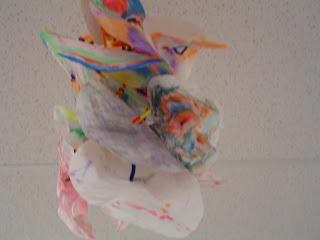
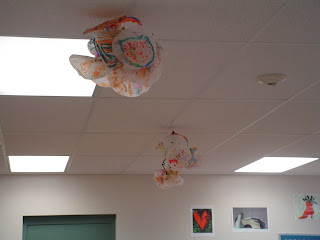
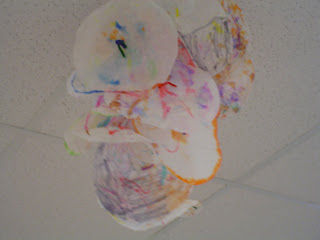
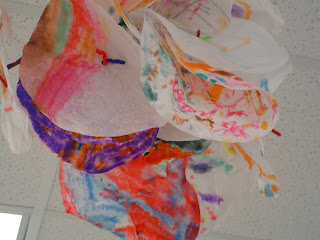
As many of you know who have been to Las Vegas, Dale Chihuly has an installation here in the Bellagio. I attempted this fall to recreate a similar installation in my art room. This was a ver successful project for my first grade students as their first art project with me. My first grade students created a coffee filter Chihuly flower. I sprayed the coffee filters with water and had the students create designs and patterns on the filters with old markers. Once the coffee filters are dry; the student will punch a pipe cleaner through the center of the filter, and twist in loops. The flowers will be displayed bunched together hanging from the ceiling.Check out http://www.chihuly.com/index.html for video and pictures of his work!
Saturday, December 22, 2007
Leftover Paper Scraps
Here are some ideas as to what to do with your paper scrap pile:
1. Make paper beads-cut the papers into triangles, put a dot of glue at the tip of the triangle, and roll up from the base.
2. Use long strips to make bookmarks
3. Cut into small squares to make mosaics.
4. Have students cut out imaginary, organic, and geometric shapes to make a collage.
1. Make paper beads-cut the papers into triangles, put a dot of glue at the tip of the triangle, and roll up from the base.
2. Use long strips to make bookmarks
3. Cut into small squares to make mosaics.
4. Have students cut out imaginary, organic, and geometric shapes to make a collage.
Labels:
art,
art education,
art program,
instruction,
lesson plan,
paper,
papermaking,
production,
teacher,
teaching
Friday, December 21, 2007
The Day Before Christmas Break
One of the art teachers in my district posted it, I don't know who wrote it, but it is so true.
Workin' in an Elementary School (Sung to the tune of Winter Wonderland)
Children scream,
they're not listenin'
When they go,
we'll not miss 'em
In all of this pain,
we try to stay sane
Workin' in an elementary school.
Christmas comes,
they're excited
Though our nerves,
they've ignited
They're off of the wall,
they run in the hall
Workin' in an elementary school.
In the lunchroom we can hear them yellin'
And we know that they are really wound
Someone hits,
the other says, "I'm tellin'"
And this is when our hearts begin to pound!
Pretty soon,
we'll be restin'
'Cause our nerves,
they've been testin'
We're happy, it's clear,
it comes once a year Christmas in an elementary school
Workin' in an Elementary School (Sung to the tune of Winter Wonderland)
Children scream,
they're not listenin'
When they go,
we'll not miss 'em
In all of this pain,
we try to stay sane
Workin' in an elementary school.
Christmas comes,
they're excited
Though our nerves,
they've ignited
They're off of the wall,
they run in the hall
Workin' in an elementary school.
In the lunchroom we can hear them yellin'
And we know that they are really wound
Someone hits,
the other says, "I'm tellin'"
And this is when our hearts begin to pound!
Pretty soon,
we'll be restin'
'Cause our nerves,
they've been testin'
We're happy, it's clear,
it comes once a year Christmas in an elementary school
Color Theory Handout
You'll want to space out the questions better and use microsoft word autoshapes to draw the necessary boxes:
Color Theory Handout-Fifth Grade
1. What are the three primary colors?
2. In the boxes below color the three primary colors.
3. What are the three secondary colors?
4. In the boxes below color the three secondary colors.
5. What are the six tertiary colors?
6. In the boxes below color the six tertiary colors.
7. What are the four neutral colors?
8. In the boxes below color the four neutral colors.
Directions: Mix the following colors together to see what you get in the boxes provided.
1. Blue and Orange
2. Red and Blue
3. Green and White
4. Red and Orange
5. Blue and Grey
6. Violet and Blue
7. Red and Brown
Directions: Write your answers in the spaces provided.
1. What does mixing white with any color do to that color?
2. What does mixing black with any color do to that color?
3. What are complimentary colors?
4. Name three sets of complimentary colors.
5. What happens when you mix two complimentary colors together?
Color Theory Handout-Fifth Grade
1. What are the three primary colors?
2. In the boxes below color the three primary colors.
3. What are the three secondary colors?
4. In the boxes below color the three secondary colors.
5. What are the six tertiary colors?
6. In the boxes below color the six tertiary colors.
7. What are the four neutral colors?
8. In the boxes below color the four neutral colors.
Directions: Mix the following colors together to see what you get in the boxes provided.
1. Blue and Orange
2. Red and Blue
3. Green and White
4. Red and Orange
5. Blue and Grey
6. Violet and Blue
7. Red and Brown
Directions: Write your answers in the spaces provided.
1. What does mixing white with any color do to that color?
2. What does mixing black with any color do to that color?
3. What are complimentary colors?
4. Name three sets of complimentary colors.
5. What happens when you mix two complimentary colors together?
Labels:
art,
art education,
art program,
color theory,
education,
elementary school,
handout,
instruction,
teacher,
teaching
Wednesday, December 19, 2007
Psychedelic Self-Portraits
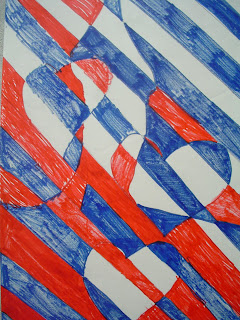
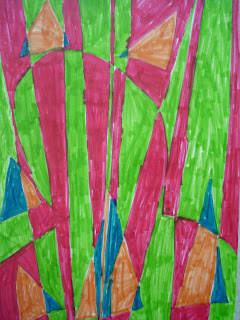
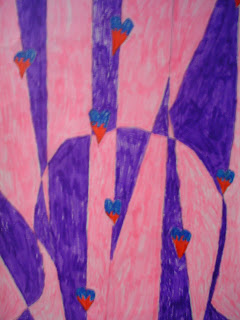
3rd grade: Psychedelic Self-Portraits- Students read John’s Secret Dreams:the Life of John Lennon by Doreen Rappaport and saw the portraits of the Beatles by Richard Avedon. Students teamed up with a partner and traced the outline of their head, neck, shoulders in pencil. Students used a ruler to draw random vertical lines across their papers. Students will use circles/shapes to break up the color scheme throughout. Students colored each section as a striped pattern using two colors that alternate in marker.
Monday, December 17, 2007
Art History Games
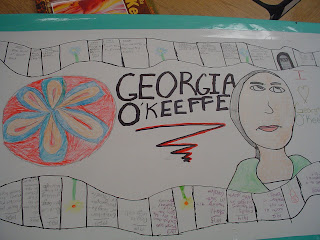
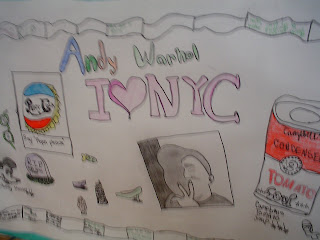
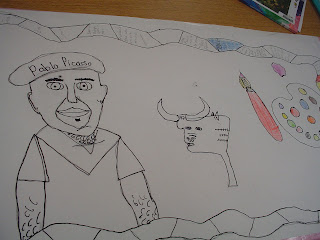
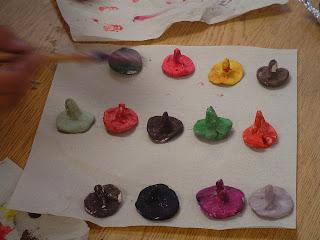
I currently have my three art clubs creating games based on the lives of famous artists. So far we have Rousseau, Warhol, Riveira, O'Keeffe, Seurat, Da Vinci, Titian, Van Gogh, Grant Wood, and Hopper. I've deivided each club into groups of four and had them research the artist and create sketches for their gameboard for three sessions before building the boards and drawing on them. I've bought dice and we used Crayola Air Dry Clay for the pieces.
Labels:
art,
art club,
art education,
art history,
art program,
games,
instruction,
interdisciplinary,
multimedia,
unit plan,
urban school
Saturday, December 15, 2007
The Insanity of Santa
Around the last few weeks before vacation the kids get wilder than usual. I try to avoid highly academic projects or projects that have a lot of steps. Instead, I focus more on fun projects that will make the kids excited enough that they stay interested and out of trouble.
1. Clay finger puppets- I show the kids how to build and add features with smaller pieces of clay. I fire them and they paint their puppets with tempera the next week.
2. Cartooning- I have a Bruce Blitz cartooning book that I share with the students. They make their own cartoon characters off of it.
3. Clay ornaments- I use tempera and glitter to decorate.
4. Watch art related movies in the classroom.
1. Clay finger puppets- I show the kids how to build and add features with smaller pieces of clay. I fire them and they paint their puppets with tempera the next week.
2. Cartooning- I have a Bruce Blitz cartooning book that I share with the students. They make their own cartoon characters off of it.
3. Clay ornaments- I use tempera and glitter to decorate.
4. Watch art related movies in the classroom.
Labels:
art,
art history,
art program,
behavior management,
clay,
crafts,
curriculum,
education,
elementary school,
holiday
First Day of Art
I tried out this suggestion for the first day of art, as did many of the art teachers at CCSD this year. Sally Moss, an elementary art teacher in the district, posted this in our forum. She says she got it from a book called Color Code. This is her email post:
I like to figure out who's who.........like who are my "leaders", who are my "reliables" , who are my "helpers" and who are my "entertainers". I tell a story about a little girl who has a mouse for show and tell.........the mouse gets loose in the classroom. Kids do different things. If you would try to help her out........color your mouse blue. If you would laugh yourself silly, color your mouse yellow, if you would try to organize everyone into detective teams, color your mouse red, and if you wish everyone would just be quiet, sit down, and let her find her own mouse, leave your mouse white.OK.................now I know who's who. I seat them accordingly.Blue (helpers) next to White ( serious workers) Next to Red (Bossy)........only 1 Yellow per table...........spread out...............They have no clue what I am doing. I did this last year and when I showed the teachers their own class's color choice, they said they were RIGHT ON! The year went much better after that.The second week I have them work on pictures for my fund raiser.This lasts about 2 weeks and then I start my regular lessons......lots of multi-culture art in my room.
I like to figure out who's who.........like who are my "leaders", who are my "reliables" , who are my "helpers" and who are my "entertainers". I tell a story about a little girl who has a mouse for show and tell.........the mouse gets loose in the classroom. Kids do different things. If you would try to help her out........color your mouse blue. If you would laugh yourself silly, color your mouse yellow, if you would try to organize everyone into detective teams, color your mouse red, and if you wish everyone would just be quiet, sit down, and let her find her own mouse, leave your mouse white.OK.................now I know who's who. I seat them accordingly.Blue (helpers) next to White ( serious workers) Next to Red (Bossy)........only 1 Yellow per table...........spread out...............They have no clue what I am doing. I did this last year and when I showed the teachers their own class's color choice, they said they were RIGHT ON! The year went much better after that.The second week I have them work on pictures for my fund raiser.This lasts about 2 weeks and then I start my regular lessons......lots of multi-culture art in my room.
Thursday, December 13, 2007
Ceramics Tip
Something that I do very often is have students practice creating their ceramic projects out of modeling clay before creating the project that will be fired. This gives students a chance to learn about the tools, building, modeling, and smoothing with their fingers rather than water.
SORRY!!!!
I'm so sorry, I haven't been on. I lost my internet connection due to a windows update. I will be back regularly posting now.
Saturday, December 8, 2007
Classroom Management Tip
Here's a great tip for pencil sharpening. Have two buckets in your room: one with freshly sharpened pencils an d another one with pencils that need sharpening. When a student finishes his work early he can sharpen the ones that need it.
Glitter Chaos
For art teachers the issue of glitter is always one that there is strong feelings about. I have used glitter before on several occasions, and with double classes.
Here are my tips:
1. For the little ones K-2 you can have them paint the glue on where they want it and come up to you and you shake the glitter on.
2. You can set up glitter stations in you classroom for older students with trays for catching the glitter.
3. You can make glitter glue that they paint on, buy glitter glue, or buy glitter paint. Some teachers feel that glitter can't be on serious artwork, I don't agree with this. When did kindergarten get so serious and drab?
Here are my tips:
1. For the little ones K-2 you can have them paint the glue on where they want it and come up to you and you shake the glitter on.
2. You can set up glitter stations in you classroom for older students with trays for catching the glitter.
3. You can make glitter glue that they paint on, buy glitter glue, or buy glitter paint. Some teachers feel that glitter can't be on serious artwork, I don't agree with this. When did kindergarten get so serious and drab?
Friday, December 7, 2007
Modigliani Style Self-Portraits
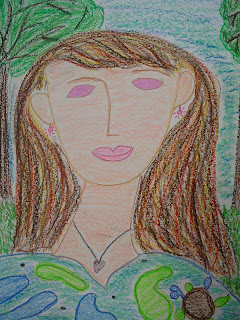
Miss Liza Camhi
Art Lesson Plan
Modigliani Self-Portrait
Grade: 4th
# of sessions: 4
Art Resources: visuals from the Girl series by Amadeo Modigliani, art criticism packet, teacher product and visual aide.
Art Materials: one 11”x14” sheet of white paper per student, pencils, erasers, and oil pastels.
Objectives-
Student will:
- create a self-portrait in the style of Amadeo Modigliani.
- create a drawing using pencils and oil pastels.- learn about the art of Modigliani.
- discuss the artwork of Modigliani according to the Principals of Design and Elements of Art.
Relation to life/Why this is important: Student will learn in detail how to apply the Elements of art and Principals of Design to an artwork.
Interdisciplinary Connections: none
Vocabulary: Amadeo Modigliani, Modern Art, Principals of Design, Elements of Art, and Self-Portrait.
Procedure:
Day 1: Teacher will introduce visuals from the Girl series by Amadeo Modigliani. Teacher will discuss the art criticism part of the lesson with the student and go over vocabulary. Student will view the visuals and begin work on art criticism packet. Student will answer the first section of the packet with the teacher’s help as to how to apply the Elements of Art to the portraits of Amadeo Modigliani. The teacher will demonstrate how to draw a self-portrait in Modigliani’s style. Student will draw his/her self-portrait and pet using pencil.
Day 2: Student will review vocabulary and teacher product/visual aide. Student will finish the art criticism packet filling in the Principals of Design section with the teacher’s help. Student will begin coloring in self-portrait.
Days 3-4: Student will review vocabulary and teacher product/visual aide. Student will finish coloring his self-portrait and present his artwork to the class.
Thursday, December 6, 2007
Online Timeline of Art
Here is an online art history timeline that is also interactive.
http://www.metmuseum.org/toah/splash.htm
http://www.metmuseum.org/toah/splash.htm
Wednesday, December 5, 2007
A Word to the Wise...
Three years ago when I began teaching, I was doing a critique using the Elements of Art for Van Gogh's Starry Night. I asked the class "How do you think this painting would feel if you touched it? Would it be smooth or bumpy?" Hands went up and I called on a fifth grade boy who asked if he could come up and feel the poster thinking it was the real painting. I realized then that my students did not understand the world of museums and art, something I take for granted coming from the urban east coast. I still run across this on a regular basis, so please take the time to explain how precious art is and that these are only copies of great masterworks.
Labels:
art,
art criticism,
art education,
art program,
critique,
education,
elementary school,
instruction,
teacher,
teaching,
urban school
R-E-S-P-E-C-T
When a class has been particularly disrespectful I have them fill out this worksheet. Then we share our answers and talk about how we can change our behavior.
1. Write a definition for the word RESPECT.
2. How can you show respect for your teacher/art teacher?
3. How can you show respect for your classmates?
4. How can you show respect for school supplies and school property?
5. What should you do if someone is not acting in a respectful manner towards the class, the teacher, or school property?
6. What should you do if someone is not acting respectful towards you?
1. Write a definition for the word RESPECT.
2. How can you show respect for your teacher/art teacher?
3. How can you show respect for your classmates?
4. How can you show respect for school supplies and school property?
5. What should you do if someone is not acting in a respectful manner towards the class, the teacher, or school property?
6. What should you do if someone is not acting respectful towards you?
Labels:
behavior management,
classroom management,
discipline,
i,
respect,
rules,
teacher,
teaching
Tuesday, December 4, 2007
Monet Lesson
Miss Liza Camhi
Art Lesson Plan
Mountain Landscape
Grade: 1st
# of sessions: 2
Art Resources: examples of Claude Monet’s Haystacks, teacher product, and visual aide.
Art Materials: one 8”x11” sheet of blue or purple paper per student, pencils, erasers, and chalk.
Objectives-
Student will:
- create a landscape drawing using bold colors and line.
- create a drawing using pencils and chalk.
- learn about the art of Claude Monet.
- learn how colors change in nature to reflect the time of day.
Relation to life/Why this is important: Student will learn how colors in nature change depending on the time of day.
Interdisciplinary Connections: History and Science
Vocabulary: Claude Monet, Landscape, and sunset.
Procedure:
Day 1: Teacher will introduce the Haystack series by Claude Monet and ask “What time of day do you think he painted this picture in?” Student will discuss how the colors become cooler and softer as the sun sets. Student will learn/discuss the meaning of the word LANDSCAPE. “How is the landscape we see outside different from the one in Claude Monet’s painting?” (mountains, desert) “If the colors in the landscape Claude Monet painted changed because the sun went down, do you think they change here when the sun sets?” Teacher will discuss colors the students will want to use in their landscape. Teacher will demonstrate how to draw a simple mountain landscape. Student will draw his landscape in pencil and hand it in.
Day 2: Student will review vocabulary and teacher product/visual aide. Student will review how colors in our landscape change as the sun sets. Student will view teacher demonstration of how to color in his landscape. Student will color his landscape and share it with the class.
For an online gallery of Monet images: http://www.intermonet.com/oeuvre/
Art Lesson Plan
Mountain Landscape
Grade: 1st
# of sessions: 2
Art Resources: examples of Claude Monet’s Haystacks, teacher product, and visual aide.
Art Materials: one 8”x11” sheet of blue or purple paper per student, pencils, erasers, and chalk.
Objectives-
Student will:
- create a landscape drawing using bold colors and line.
- create a drawing using pencils and chalk.
- learn about the art of Claude Monet.
- learn how colors change in nature to reflect the time of day.
Relation to life/Why this is important: Student will learn how colors in nature change depending on the time of day.
Interdisciplinary Connections: History and Science
Vocabulary: Claude Monet, Landscape, and sunset.
Procedure:
Day 1: Teacher will introduce the Haystack series by Claude Monet and ask “What time of day do you think he painted this picture in?” Student will discuss how the colors become cooler and softer as the sun sets. Student will learn/discuss the meaning of the word LANDSCAPE. “How is the landscape we see outside different from the one in Claude Monet’s painting?” (mountains, desert) “If the colors in the landscape Claude Monet painted changed because the sun went down, do you think they change here when the sun sets?” Teacher will discuss colors the students will want to use in their landscape. Teacher will demonstrate how to draw a simple mountain landscape. Student will draw his landscape in pencil and hand it in.
Day 2: Student will review vocabulary and teacher product/visual aide. Student will review how colors in our landscape change as the sun sets. Student will view teacher demonstration of how to color in his landscape. Student will color his landscape and share it with the class.
For an online gallery of Monet images: http://www.intermonet.com/oeuvre/
Monday, December 3, 2007
Art Based Fundraisers
Here are some programs where you can use student artwork as fundraising method. A portion of the proceeds can go to your school, district, or program depending on the fundraiser. This is great if you have a small budget or want to do something special with your students and needs the money to do so. Many of these fundraisers will display student work on t-shirts, mugs, posters, totes, etc. that parents can buy as mementos-so it's also a good advertisement for your program.
http://www.kidsartinc.com/http://www.artsonia.com/teachers/
http://www.originalworks.com/http://www.school-fundraisers.com/art-fundraising-ideas.htm
http://www.displaymyart.com/?gclid=CN_yu6ncjJACFQJnYQodKlS6rw
http://www.kidsartinc.com/http://www.artsonia.com/teachers/
http://www.originalworks.com/http://www.school-fundraisers.com/art-fundraising-ideas.htm
http://www.displaymyart.com/?gclid=CN_yu6ncjJACFQJnYQodKlS6rw
Saturday, December 1, 2007
To Yell or Not to Yell That is the Question...
The first week of school I lose my voice every year. I feel that by being more authoritative the first couple weeks, especially when the students are learning procedures and rules is important. I raise my voice and have a very serious expression on my face. I'm a young female teacher, so all in all I'm not intimidating-but sometimes I need to be. I had a class this year come in that were not under control for anyone. They were wild for their teacher, specialists, and subs. So the first time I met them, they were very sure to let me know who they were and what they were about. I made them put their heads down the whole period and gave them a lecture on entering my classroom correctly-a 50 minute lecture. The next week they gave me dirty looks as they gloomilly walked into my room. "Are we going to do art today?" was the question du jour. I answered "That's not really up to me as much as it is up to you." We sat down and took attendance- three times until they did so correctly. We talked about last week and what went wrong for about twenty minutes while also going over the rules and procedures. Then we painted. They were thrilled. Two weeks later they were my first class to use clay and they actually said thank you. One of the boys in that class told me "I'm only good for you and my daddy. You make me so frustrated." That made me happy. They are one of my best behaved classes now and best-loved.
I will not say whether raising your voice is right or wrong, I think it just depends on the situation.
I will not say whether raising your voice is right or wrong, I think it just depends on the situation.
Labels:
art education,
behavior management,
discipline,
education
Friday, November 30, 2007
Unit on Georgia O'Keeffe



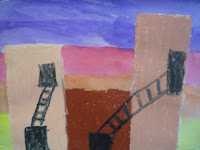
Miss Liza Camhi
Art Unit
Georgia O’Keeffe
Grade: 5th
# of lessons: 3
Art Resources: Artists in Their Time Georgia O’Keeffe by Ruth Thomson, examples of pueblos and adobe homes in photographs, photographs or actual animal skulls, examples of Georgia O’Keeffe’s flower paintings, pictures of flowers, and teacher products.
Art Materials:1 sheet of white 9”x12” paper per student, watercolors, water cups, pencils, paintbrushes, glue, 2 sheets of 8”x8” white paper per student, 1 11”x14” sheet of black paper, cups of glue and water mixed together, oil pastels, and 1 11”x14” sheet of white paper.
Objectives-
Student will:
- create a multimedia southwestern landscape
- create an observational collage and pencil drawing of a flower
- create a painting of animal bones of flowers
- learn about the process of collaging- use various watercolor techniques
- shade using a pencil and create a grayscale
- draw using oil pastels
- learn about the life and art of Georgia O’Keeffe
- work in groups and individually
Interdisciplinary Connections: Science and Social Studies
Vocabulary: Georgia O’Keeffe, still life, landscape, Southwest, grayscale, shade, and adobe.
Lessons: The unit will consist of the following components:
A. Multimedia Adobe Landscape- Each student will paint a watercolor sunset on 9”x12” sheets of white paper. The student will then draw adobe homes using oil pastel.
B. Georgia O’Keeffe Flower Study- Each student will create an 8 square grayscale using pencil on strips of scrap white paper. Student will share a photograph of a flower with a group of 3 students and individually draw/shade a flower composition on 8’x8” white paper in pencil. Then he will redraw the outline of his flower composition on another 8”x8” white sheet of paper and collage with tissue paper scraps. Student will mat his work on 11”x14” black paper with glue.
C. Flower and Bones Painting- Student will draw in pencil on 11”x14” white paper a skull and a flower from studying photographs. Student will paint the picture using watercolors.
Labels:
art,
art education,
art program,
elementary school,
georgia o'keeffe,
lesson plan,
unit plan
Thursday, November 29, 2007
Closing a Lesson
One of the parts of lesson planning I struggled with most is the daily closing. My solution for this has been to review art history facts that go along with the lesson and discuss the procedures for the next step of the lesson. If you have any other suggestions you can email me at LCSC1980@aol.com or post them to the blog.
Labels:
art education,
art history,
art program,
lesson plan,
procedures
Wednesday, November 28, 2007
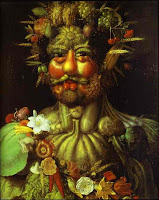
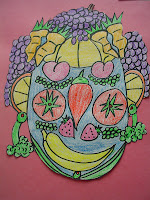
Here's a great lesson for fall or Thanksgiving. It can also be used for health cross-curricular activities.
Miss Liza Camhi
Art Lesson Plan~Veggie Heads
Grade(s): 3rd
# of sessions: 3
Art Resources:~ teacher’s example, examples of Renaissance art, paintings by Giuseppe Arcimboldo, and visual aide.Art Materials: 1 sheet of 11”x14” white paper per student, pencils, black markers, and crayons.
Objectives- Student will: ~
*learn about the art of Giuseppe Arcimboldo.
*create a portrait made of drawn fruits and vegetables.
*use crayon, pencils, and black marker to create his/her portrait.
*learn about proportion.
*create a portrait made of drawn fruits and vegetables.
*use crayon, pencils, and black marker to create his/her portrait.
*learn about proportion.
Relation to life/Why this lesson is important: Considering Arcimboldo is a contemporary of the Italian Renaissance artists the student will learn about the importance of being unique and how artists have used their creative ideas to change art. This is also an introduction to proportion.
Interdisciplinary Connections: History, Health, and Science
Vocabulary: Giuseppe Arcimboldo, proportion, and Renaissance.
Procedure:
Day 1: Show students examples of Italian Renaissance art such as Mona Lisa or the Pieta. Discuss that Renaissance means “the best” as applied to art. Students will participate in a discussion about portraits by Giuseppe Arcimboldo (“What are these pictures of and how can you tell?” “What makes these portraits unique?”). Teacher will explain how Arcimboldo used fruits and vegetables to create a portrait. Student will view teacher product and go over the steps of the project. Student will watch teacher demonstrate how to layout his composition and add the fruits and vegetables. The teacher should start with a simple circle and ask students to help him/her think of fruits and vegetables to fill in the features. This is when the teacher should start going over proportion. The students should understand to pick fruits and vegetables that are similar in size and shape to facial features. Student will draw his portrait in pencil on white paper.
Day 2: Review vocabulary and art history.~ Student will trace his drawing in black marker. Once the tracing is complete the student may color the portrait in with crayon.
Day 3: Review vocabulary and art history.~ Student will finish coloring his composition with crayon. Student will cut out his mask and hand in.
For more picture of Arcimboldo's work check out:http://www.abcgallery.com/A/arcimboldo/arcimboldo.html
Labels:
art,
art education,
art history,
art program,
autumn,
curriculum,
education,
elementary school,
fall,
interdisciplinary,
lesson plan
Art Books I Reccommend
I love to read to my students as a way of teaching them art history. Here are some really cool books, and I'll share with you how I use them.
When Pigasso Met Mootisse by Nina Laden- I have an entire unit I do with Picasso and Matisse. I use the book to kick start the unit and explain the relationship between these two artists.
One Day In Japan with Hokusai by Julia Altman- This book is filled with gorgeous illustrations and many of Hokusai's most famous works. I would use this in May during Pacific Islander month to accompany our fish sculptures, printmaking, and paper weaving kimonos.
Pablo Picasso: Breaking All the Rules- This book is part of a series based on written reports by real kids that were published. Kids love this book, and the fact that it was created by someone their age. I have one on Matisse as well.
When Pigasso Met Mootisse by Nina Laden- I have an entire unit I do with Picasso and Matisse. I use the book to kick start the unit and explain the relationship between these two artists.
One Day In Japan with Hokusai by Julia Altman- This book is filled with gorgeous illustrations and many of Hokusai's most famous works. I would use this in May during Pacific Islander month to accompany our fish sculptures, printmaking, and paper weaving kimonos.
Pablo Picasso: Breaking All the Rules- This book is part of a series based on written reports by real kids that were published. Kids love this book, and the fact that it was created by someone their age. I have one on Matisse as well.
Labels:
art,
art education,
art history,
art program,
books,
curriculum,
education,
elementary school,
instruction
Tuesday, November 27, 2007
Drawing Machines
Check out this site to explain drawing machines. It's a great way to combine technology and art. If you are teaching perspective and doing grid work you could discuss with your students many of the machines on this page such as the Perspectograph which was used similar to how we use grids in art education classes today.It also ties into proportion, Durer, and Da Vinci. Another idea is to see if your students could build something similar to one of these machines and use it for a work of art. http://www.acmi.net.au/AIC/DRAWING_MACHINES.html
Valuable Holiday Art Lessons
A lot of teachers do holiday projects like turkey hands, Christmas tree ornaments, and handmade valentines. I say why not push the boundaries and make holiday art REAL ART. Why not learn about Grandma Moses and make (paper) quilt pieces that depict family around the holidays? Instead of just coloring hearts on Valentines, why not make handmade paper hearts and learn about a process? I've added one of my lesson plans I do on Velentine's Day that incorporates printmaking and the artist Jim Dine. For the printing plates I laminated 11"x14" white paper sheets.
Miss Liza Camhi
Art Lesson Plan
Jim Dine Monoprints
Grade: 1st -5th
# of sessions: 1
Art Resources: examples of Jim Dine Heart series and teacher product.
Art Materials: one 8”x10” sheet of white paper per student, monoprint plates , tempera paint, water, and brushes.
Objectives-
Student will:
- create a monoprint in the style of Jim Dine.
- learn printmaking methods.
- create a monoprint of a heart.Relation to life/Why this is important: This lesson teaches students printmaking methods which they will continue to learn in middle school and high school.
Interdisciplinary Connections: N/AVocabulary: Jim Dine, Monoprint, Pop Art
Procedure:
Day 1: Teacher will introduce examples of monoprints made by Jim Dine. Teacher will discuss how a monoprint is created. Teacher will demonstrate how to create a monprint. Student will paint tempera on monoprint plate. Once heart and background are created, student will press paper onto plate and pull off. If they were not successful on their first attempt, they will repeat the process until they have created a successful monprint.
Miss Liza Camhi
Art Lesson Plan
Jim Dine Monoprints
Grade: 1st -5th
# of sessions: 1
Art Resources: examples of Jim Dine Heart series and teacher product.
Art Materials: one 8”x10” sheet of white paper per student, monoprint plates , tempera paint, water, and brushes.
Objectives-
Student will:
- create a monoprint in the style of Jim Dine.
- learn printmaking methods.
- create a monoprint of a heart.Relation to life/Why this is important: This lesson teaches students printmaking methods which they will continue to learn in middle school and high school.
Interdisciplinary Connections: N/AVocabulary: Jim Dine, Monoprint, Pop Art
Procedure:
Day 1: Teacher will introduce examples of monoprints made by Jim Dine. Teacher will discuss how a monoprint is created. Teacher will demonstrate how to create a monprint. Student will paint tempera on monoprint plate. Once heart and background are created, student will press paper onto plate and pull off. If they were not successful on their first attempt, they will repeat the process until they have created a successful monprint.
Monday, November 26, 2007
Glaze and Bisque Firing at the Same Time
During one of my student teaching placements I did a bisque/glaze firing. The students had glazed their greenware with underglazes and two coats of clear glaze. If you want to do this in order to save time and electricity here are some suggestions:
1. The clay pieces are best flat and small, like tiles. This way they dry quickly and if they break, are less likely to stick to the walls/shelves of the kiln.
2. Place the pieces on stilts so they do not stick to the walls and shelves of the kiln.
3. Instead of firing with the glaze on, you could do a bisque firing and paint the bbisqueware with watercolor and Krylon spray for a shiny seal.
1. The clay pieces are best flat and small, like tiles. This way they dry quickly and if they break, are less likely to stick to the walls/shelves of the kiln.
2. Place the pieces on stilts so they do not stick to the walls and shelves of the kiln.
3. Instead of firing with the glaze on, you could do a bisque firing and paint the bbisqueware with watercolor and Krylon spray for a shiny seal.
Artsonia.com
I was recently made aware of this amazing site for student art. You can post pictures of student work in an online art museum. Parents can go online and see their child's work and post comments. Parents can also purchase keepsakes such as mugs, t-shirts, teddy bears, etc. with their student's work printed on it and 15% of the money spent goes back to the school. I can't wait to use this site! It's http://www.artsonia.com/
Labels:
art,
art education,
art program,
curriculum,
fundraiser,
fundraising
Sunday, November 25, 2007
Components of a Lesson Plan
I'm attaching the lesson plan created by Madeline Hunter. This is the lesson plan model used by many school districts, often the steps of this plan are asked about in interviews, and many colleges have adapted it.
http://template.aea267.iowapages.org/lessonplan/
http://template.aea267.iowapages.org/lessonplan/
Labels:
curriculum,
education,
lesson plan,
madeline hunter
Friday, November 23, 2007
An Easy Way to do Papermaking
Papermaking with a large group can be tough in terms of supplies and mess. So this is my advice. Make the paper pulp for the students before they lesson and store it. Demonstrate how you made it for them when you start the lesson so they can understand the process. Rather than use screens, which you would need many depending on the class size, have them press the pulp into shapes and add inks to color. You could also have dried flowers and textiles for your students to press into the pulp.
Labels:
art,
art education,
autumn,
crafts,
curriculum,
instruction,
multimedia,
paper,
papermaking
Wednesday, November 21, 2007
Some Financial Tips for A New Teacher
Yay! All your hard work has paid off, you have job, retirement pention, and more work than you could have ever imagined. On top of that, you're not making a lot of money. If you're like most new grads starting out, you have debt. College loans, moving expenses, and credit cards have mounted up before your first paycheck. Don't worry, you're not alone. It seems like most, if not all, new teachers start out like this. Here are some tips I have picked up along the way:
1. Don't get into the habit of spending more than you can spare. Create a budget. The first few months may be really tight, but so what? You're so busy lesson planning and catching zzz's in between you don't really feel like going out and spending.
2. Curb celebratory spending. You may be making the most money you've ever made, that doesn't mean you should spend your first summer off in France travelling on a credit card or buy a house that you can't afford, but "is a really good investment."
3. Start putting away in a 401(k), 403(b), or Roth IRA as soon as you can. Even 20 dollars a paycheck is worth it.
4. Pay off credit card debt as quick as possible, with our new credit accounts the APR is usually pretty steep and the interest will add up.
5. Don't get me wrong, if you can own rather than rent do it by all means, it is the best investment of your life.
6. Save receipts from your college courses, moving expenses, and classroom shopping. Use them for your tax return.
7. I read this book and highly reccommend it. Suze Orman's Young, Fabulous, and Broke. Check out her site at:http://www.suzeorman.com/
1. Don't get into the habit of spending more than you can spare. Create a budget. The first few months may be really tight, but so what? You're so busy lesson planning and catching zzz's in between you don't really feel like going out and spending.
2. Curb celebratory spending. You may be making the most money you've ever made, that doesn't mean you should spend your first summer off in France travelling on a credit card or buy a house that you can't afford, but "is a really good investment."
3. Start putting away in a 401(k), 403(b), or Roth IRA as soon as you can. Even 20 dollars a paycheck is worth it.
4. Pay off credit card debt as quick as possible, with our new credit accounts the APR is usually pretty steep and the interest will add up.
5. Don't get me wrong, if you can own rather than rent do it by all means, it is the best investment of your life.
6. Save receipts from your college courses, moving expenses, and classroom shopping. Use them for your tax return.
7. I read this book and highly reccommend it. Suze Orman's Young, Fabulous, and Broke. Check out her site at:http://www.suzeorman.com/
Discipline Based Art Education in Motion
I gave an excellent description of DBAE in a previous post: http://hiartteacher.blogspot.com/2007/11/some-interview-questions-and-answers.html
So how do you incorporate DBAE, state standards, and possibly national standards into the same lesson plan? First of all the standards and DBAE are intertwined. Many standards have art history, aesthetic, criticism, and studio components. So as long as you know your state standards you should easily be able to make the connections. (A good interview Q&A)
In my lessons; when I first introduce a new artist I give some background on the artist's life and the period of his work. Many times I will read from an art history book like the Mike Venezia series. http://www.mikevenezia.com/mikevenezia/ I also show and discuss a major work by the artist. That can be the art history and part of the criticism/aesthetics sections.
Throughout the studio process I am looking for a similarity in process or technique as the artist we are studying in my students' works. I am always giving feedback and comparing/contrasting their work with the exemplar. That is a second aesthetic and critical component. Lastly when I grade, I do so with my student there and we discuss what was successful and what was not, that is the last critical component.
So how do you incorporate DBAE, state standards, and possibly national standards into the same lesson plan? First of all the standards and DBAE are intertwined. Many standards have art history, aesthetic, criticism, and studio components. So as long as you know your state standards you should easily be able to make the connections. (A good interview Q&A)
In my lessons; when I first introduce a new artist I give some background on the artist's life and the period of his work. Many times I will read from an art history book like the Mike Venezia series. http://www.mikevenezia.com/mikevenezia/ I also show and discuss a major work by the artist. That can be the art history and part of the criticism/aesthetics sections.
Throughout the studio process I am looking for a similarity in process or technique as the artist we are studying in my students' works. I am always giving feedback and comparing/contrasting their work with the exemplar. That is a second aesthetic and critical component. Lastly when I grade, I do so with my student there and we discuss what was successful and what was not, that is the last critical component.
Tuesday, November 20, 2007
OOOOOOH...He said a Bad Word!!!
This is one of the best tips I ever received. If a student says a bad word and you catch him, or he confesses, make him call his parents/guardians right then and there in the classroom and say it to them on the phone. If you make this your policy and let it be known, the kids will be too scared to say bad words in your classroom.
Labels:
behavior management,
discipline,
education,
elementary school
The Kiln is a Disaster!
What do you do so when you open the kiln it doesn't look like a grenade went off and destroyed all of your projects?
1. Do not hollow a closed ceramic object, that's just asking for it.
2. If something is very thick create a hollow area that comes through one end of the clay object.
3. Let your green ware dry at least five, if not a week before firing.
4. Teach your students how to properly wedge, that means not pounding it into oblivion!
5. Set the first firing for one-two hours so to let the moisture out, the second for an hour, then let it run for the final firing.
What if you do have an explosion?
1. Get all the large pieces of pottery shards out with your hands and throw them out.
2. Have a custodian come in and vacuum out the remaining small pieces and dust. The dust is highly toxic.
1. Do not hollow a closed ceramic object, that's just asking for it.
2. If something is very thick create a hollow area that comes through one end of the clay object.
3. Let your green ware dry at least five, if not a week before firing.
4. Teach your students how to properly wedge, that means not pounding it into oblivion!
5. Set the first firing for one-two hours so to let the moisture out, the second for an hour, then let it run for the final firing.
What if you do have an explosion?
1. Get all the large pieces of pottery shards out with your hands and throw them out.
2. Have a custodian come in and vacuum out the remaining small pieces and dust. The dust is highly toxic.
Monday, November 19, 2007
Classroom Management Tip
Don't just call home with negative reports concerning a student, make positive calls as well. This fall I entered my students in 3 contests. I called home for every student I wanted to enter (which was literally about 65 phone calls). In doing so the parents became excited about the art program at our school. I began meeting many of the parents, as they would stop by to say hi and check on their child. I also had some extra supplies trickle in. So it was definitely worth it and any opportunity you have to call home about something positive-do it!
Mike Venezia
I am sure that many experienced art educators are familiar with the Getting to Know the World's Greatest Artists series but for those of you who new to the profession-start collecting now! I find these books so valuable in teaching art history and criticism to my students. The books are elementary-middle school aged appropriate, few have any nudes, and they have great cartoon illustrations that excite the kids. If you are not an art teacher, he also has a series about the US Presidents and Famous Composers. You could literally create a whole curriculum based on his books. There are 48 in the artist series alone! For more information check out:http://www.mikevenezia.com/
What Should I Leave for a sub?
My rule of thumb is this, leave 5-6 simple lesson plans that a non-artist could teach. The lesson plans do not have to be filled with rubrics, standards, etc. unless your administrator asks for that. I just write down the materials, resources and procedures step-by-step. I keep the materials very simple such as cut and paste, drawing, coloring-nothing messy and nothing to build. I personally have not had much success with having subs teach my lessons, so beware, they are often better off doing something special with the students for that day. Along with the plans I leave a teacher exemplar, any copies, any books, and all the materials necessary together on my desk. I also leave a schedule, my lesson plan book with their lessons added into it, and a sheet regarding classroom management/procedures. I hope this helps.
Labels:
curriculum,
education,
instruction,
lesson plan,
substitute,
teacher,
teaching
Sunday, November 18, 2007
A Great Lesson to Introduce Kindergarteners to Art Class
My kindergartners are some of my favorite students. They are so cute and sweet, but when it comes to art they don't have much experience to draw from. They are not independent to start off with so I created this unit to give them the opportunity to familiarize themselves with the art materials and to become independent works.
Miss Liza Camhi
Art Unit
Art Materials and Processes
Grade: K
# of lessons: 5
Art Resources: mystery boxes, teacher products and visual aide.
Art Materials: modeling clay, clay, scissors, glue, paint, paintbrushes, water containers, water, poster board, yarn, texture materials, hole punchers, paper towels, cotton swabs, construction paper, white paper, and crayons.
Major Goals/ N.V. State Standards addressed in this lesson:
1.0 Students know and apply visual arts media, techniques, and processes.
2.0 Students use knowledge of visual characteristics, purposes, and functions.
3.0 Students choose, apply, and evaluate a range of subject matter, symbols and ideas.
5.0 Students analyze and assess characteristics, merits, and meanings in their own artwork and the work of others.
Objectives- Student will:
-create works of art in a variety of media
-learn an art vocabulary that relates to art media and processes
-experiment with a variety of art processes
-create works of art in a variety of subject matter
Relation to life/Why this is important: Student will gain basic knowledge of how use a variety of art media in the classroom.
Interdisciplinary Connections: N/A
Vocabulary: clay, model, texture, collage, paint, paintbrush, texture, drawing, design, pendant.
Lessons: The unit will consist of the following components:
Las Vegas Poster- A group of four students will create a poster of Las Vegas landmarks. Students will draw in crayon on 12”x24”paper and reference photographs of local landmarks.
Texture Collage- 4 mystery boxes will be passed around the room. The student will stick his hand inside to touch the mystery object and then will describe how it feels. Student will then create a collage of different materials with different textures. Once the collage is complete, the student will paint over the materials so they blend with the background.
Winter Landscape Painting- Student will create a painting using white tempera paint on light blue paper. Student will create a sense of space in his painting by dabbling paint on lightly at first with a crumpled cloth, then adding more paint as he creates layers. Student will use the cotton swabs to create snowy trees.
My Best Pendant- Students will draw two circles. Student will draw inside of the two circles a picture of himself when he does his best in crayon. Student will cut out the two circles, glue them together, and punch a hole. Teacher will add yarn to hang the pendant on.
Assessment: Las Vegas Drawing will be graded on participation by E,S,N. Others projects will be graded on and E,S,N scale with a rubric.
Miss Liza Camhi
Art Unit
Art Materials and Processes
Grade: K
# of lessons: 5
Art Resources: mystery boxes, teacher products and visual aide.
Art Materials: modeling clay, clay, scissors, glue, paint, paintbrushes, water containers, water, poster board, yarn, texture materials, hole punchers, paper towels, cotton swabs, construction paper, white paper, and crayons.
Major Goals/ N.V. State Standards addressed in this lesson:
1.0 Students know and apply visual arts media, techniques, and processes.
2.0 Students use knowledge of visual characteristics, purposes, and functions.
3.0 Students choose, apply, and evaluate a range of subject matter, symbols and ideas.
5.0 Students analyze and assess characteristics, merits, and meanings in their own artwork and the work of others.
Objectives- Student will:
-create works of art in a variety of media
-learn an art vocabulary that relates to art media and processes
-experiment with a variety of art processes
-create works of art in a variety of subject matter
Relation to life/Why this is important: Student will gain basic knowledge of how use a variety of art media in the classroom.
Interdisciplinary Connections: N/A
Vocabulary: clay, model, texture, collage, paint, paintbrush, texture, drawing, design, pendant.
Lessons: The unit will consist of the following components:
Las Vegas Poster- A group of four students will create a poster of Las Vegas landmarks. Students will draw in crayon on 12”x24”paper and reference photographs of local landmarks.
Texture Collage- 4 mystery boxes will be passed around the room. The student will stick his hand inside to touch the mystery object and then will describe how it feels. Student will then create a collage of different materials with different textures. Once the collage is complete, the student will paint over the materials so they blend with the background.
Winter Landscape Painting- Student will create a painting using white tempera paint on light blue paper. Student will create a sense of space in his painting by dabbling paint on lightly at first with a crumpled cloth, then adding more paint as he creates layers. Student will use the cotton swabs to create snowy trees.
My Best Pendant- Students will draw two circles. Student will draw inside of the two circles a picture of himself when he does his best in crayon. Student will cut out the two circles, glue them together, and punch a hole. Teacher will add yarn to hang the pendant on.
Assessment: Las Vegas Drawing will be graded on participation by E,S,N. Others projects will be graded on and E,S,N scale with a rubric.
Labels:
art education,
art program,
ceramics,
clay,
curriculum,
education,
instruction,
Kindergarten,
lesson plan,
production,
studio,
unit plan
My Favorite Plan for Behavior Management-Positive Reinforcement
I've had classes and individual students who were extremely challenging. One bad apple can ruin the bunch, when the bunch is constantly reacting to the bad apple. This idea was given to me by one of my mentors when I had a very difficult class.Behavior Lottery- You need to have raffle tickets at hand and little prizes from the dollar store work great. Tell the class you would like to do something very special today with them, because they are some of your favorite kids. They have to earn the raffle tickets based on behavior, staying on task, and following procedure. The better they are, the more raffle tickets they earn, the more likely to win a prize. You want to show them the prizes they could earn to motivate and grab their interest. As you give them raffle tickets (which you can print out from the web for free) they will write their names on them and drop them into a jar. Once they are cleaned up at the end of the period shake the jar and pull for the raffle, I do about three prizes/winners a week. The kids all clap and are thrilled for their classmates. I write the winners down and if they ever win again before everyone else has had a chance, they can pull for the raffle winner instead of me.This idea has worked for double classes in which several students do not get along and it was total mayhem, now these classes are some of my favorites.
Friday, November 16, 2007
Bruce Blitz Videos Rock!
So Wednesday I had a runny nose, yesterday my ears were so clogged I couldn't hear, and today the classroom spinned. I didn't want to leave early, so instead I popped in a Bruce Blitz cartooning video. The kids laughed and were mesmerized by his drawing skills. I got through the day and the kids had a great time!
Student Teachers Hired
Last fall we had two student teachers come out to Vegas to student teach at our school. Both were offered a job and their own classrooms when they had completed the student teaching program. Check out this opportunity through your college program!
Thursday, November 15, 2007
Classroom Management Tip
With names getting more creative and harder to pronounce these days when you get stuck on a name just say “Wow this name looks super cool, but I’m not sure how to pronounce it.” The kids whose names are tough will appreciate the compliment rather than the mispronunciation of their name.
Help for Writing Rubrics
The first time I was asked to write a rubric I had no clue what one was. I was told to research them and write one for a lesson I was planning. Luckily I have to parents who are teachers and were able to guide me through. If you don't have teaching parents here are some websites to help you out.
http://rubistar.4teachers.org/index.php creates rubrics for you, and has specialized art rubrics
http://www.teach-nology.com/web_tools/rubrics/ creates rubrics for you
http://school.discoveryeducation.com/schrockguide/assess.html#rubrics the ultimate rubric site for any teacher-links to external websites about rurics
http://rubistar.4teachers.org/index.php creates rubrics for you, and has specialized art rubrics
http://www.teach-nology.com/web_tools/rubrics/ creates rubrics for you
http://school.discoveryeducation.com/schrockguide/assess.html#rubrics the ultimate rubric site for any teacher-links to external websites about rurics
Wednesday, November 14, 2007
Classroom Management Tip
The first day of school have your rules and procedures posted. Go over them, practice them with the kids. If they can get up and can move during procedures like practicing the fire drill, clean up, line up they will pay better attention.
Rousseau's Jungle Lesson

Miss Liza Camhi
Art Lesson Plan
Rousseau Jungle Drawing
Grade: 3rd
# of sessions: 3
Art Resources: Virgin Jungle by Henri Rousseau, Jungle animal pictures VA, and teacher product.
Art Materials: one 8”x11” sheet of white paper per student, rulers, pencils, erasers, and crayons.
Major Goals/ N.V. State Standards addressed in this lesson:
1.0 Students know and apply visual arts media, techniques, and processes.
2.0 Students use knowledge of visual characteristics, purposes, and functions.
3.0 Students choose, apply, and evaluate a range of subject matter, symbols and ideas.
4.0 Students understand the visual arts in relation to history and cultures.
5.0 Students analyze and assess characteristics, merits, and meanings in their artwork and the work of others.
Objectives- Student will:
- create a drawing using organic shapes and line.
- create a drawing using pencils and crayons.
- learn about the art and life of Henri Rousseau.
- create a drawing in the style Henri Rousseau.
Relation to life/Why this is important: Student will learn how artists use their imagination in order to create their artwork. Student will learn how outsider artists taught themselves to create art with no formal training.
Interdisciplinary Connections: History and Science
Vocabulary: Henri Rousseau, Outsider Art, pattern, and organic shapes.
Procedure: Day 1: Teacher will introduce Virgin Jungle by Henri Rousseau and discuss subject matter and elements of art. Student will discuss how they can tell the painting is not completely realistic. Student will play art history game by arranging facts about Henri Rousseau in order with the classmates at the table. The teacher will call on students to help create a class outline of Rousseau’s life using their art history facts in order. Student will review jungle animal VA. Teacher will demonstrate how to sketch a jungle composition on white paper. Student will sketch jungle scene in pencil and begin tracing in black. Day 2: Student will review vocabulary, Virgin Jungle by Henri Rousseau, and teacher product/visual aide. Student will finish tracing sketch in black crayon. Student will begin coloring in drawing. Day 3: Student will review vocabulary, Virgin Jungle by Henri Rousseau, and teacher product/visual aide. Student will finish coloring his drawing.
Lesson Criteria
Criteria
Excellent
Satisfactory
Needs Improvement
Student drew at animals in his jungle scene.
Student drew one or more jungle animals in his jungle scene.
Student drew one or more jungle animals in his jungle scene, but could have been neater.
Student did draw a jungle animal.
Student drew a jungle scene.
Student used ¾ of his page to draw his jungle scene.
Student used ½
of his page to draw his jungle scene.
Student used less than ½
of his page to draw his jungle scene.
Student created a frame for his jungle scene.
Student created a colorful, neatly colored frame for his drawing.
Student created a frame for his jungle scene, but could have been neater.
Student did not create a frame.
Behavior
Student demonstrated listening to and following directions in class.
Student demonstrated listening to and following directions in class by knowing how to complete the assignment.
Student demonstrated listening to and following directions in class with little need for repetition of directions.
Student did not demonstrate
listening to and following directions in class by needing several repetitions of directions.
Student was respectful to his peers and teacher during lesson.
Student was respectful to his peers and teacher during lesson by not disrupting the class.
Student was respectful to his peers and teacher during lesson with few disruptions.
Student was not respectful to his peers and teacher during lesson with several disruptions.
Art Lesson Plan
Rousseau Jungle Drawing
Grade: 3rd
# of sessions: 3
Art Resources: Virgin Jungle by Henri Rousseau, Jungle animal pictures VA, and teacher product.
Art Materials: one 8”x11” sheet of white paper per student, rulers, pencils, erasers, and crayons.
Major Goals/ N.V. State Standards addressed in this lesson:
1.0 Students know and apply visual arts media, techniques, and processes.
2.0 Students use knowledge of visual characteristics, purposes, and functions.
3.0 Students choose, apply, and evaluate a range of subject matter, symbols and ideas.
4.0 Students understand the visual arts in relation to history and cultures.
5.0 Students analyze and assess characteristics, merits, and meanings in their artwork and the work of others.
Objectives- Student will:
- create a drawing using organic shapes and line.
- create a drawing using pencils and crayons.
- learn about the art and life of Henri Rousseau.
- create a drawing in the style Henri Rousseau.
Relation to life/Why this is important: Student will learn how artists use their imagination in order to create their artwork. Student will learn how outsider artists taught themselves to create art with no formal training.
Interdisciplinary Connections: History and Science
Vocabulary: Henri Rousseau, Outsider Art, pattern, and organic shapes.
Procedure: Day 1: Teacher will introduce Virgin Jungle by Henri Rousseau and discuss subject matter and elements of art. Student will discuss how they can tell the painting is not completely realistic. Student will play art history game by arranging facts about Henri Rousseau in order with the classmates at the table. The teacher will call on students to help create a class outline of Rousseau’s life using their art history facts in order. Student will review jungle animal VA. Teacher will demonstrate how to sketch a jungle composition on white paper. Student will sketch jungle scene in pencil and begin tracing in black. Day 2: Student will review vocabulary, Virgin Jungle by Henri Rousseau, and teacher product/visual aide. Student will finish tracing sketch in black crayon. Student will begin coloring in drawing. Day 3: Student will review vocabulary, Virgin Jungle by Henri Rousseau, and teacher product/visual aide. Student will finish coloring his drawing.
Lesson Criteria
Criteria
Excellent
Satisfactory
Needs Improvement
Student drew at animals in his jungle scene.
Student drew one or more jungle animals in his jungle scene.
Student drew one or more jungle animals in his jungle scene, but could have been neater.
Student did draw a jungle animal.
Student drew a jungle scene.
Student used ¾ of his page to draw his jungle scene.
Student used ½
of his page to draw his jungle scene.
Student used less than ½
of his page to draw his jungle scene.
Student created a frame for his jungle scene.
Student created a colorful, neatly colored frame for his drawing.
Student created a frame for his jungle scene, but could have been neater.
Student did not create a frame.
Behavior
Student demonstrated listening to and following directions in class.
Student demonstrated listening to and following directions in class by knowing how to complete the assignment.
Student demonstrated listening to and following directions in class with little need for repetition of directions.
Student did not demonstrate
listening to and following directions in class by needing several repetitions of directions.
Student was respectful to his peers and teacher during lesson.
Student was respectful to his peers and teacher during lesson by not disrupting the class.
Student was respectful to his peers and teacher during lesson with few disruptions.
Student was not respectful to his peers and teacher during lesson with several disruptions.
The Internet Sites I LOVE for my Classroom
http://www.princetonol.com/groups/iad/index.html for lesson ideas
http://www.crayola.com lesson ideas and worksheet activities for early finishers
http://www.metmuseum.org/explore/museumkids.htm?HomePageLink=museumkids_c
they have online interactive presentations on artists and styles
http://www.dickblick.com/ great sales on supplies and resources for the classroom
http://www.michaels.com/art/online/home lesson ideas and supplies
http://www.enasco.com/artsandcrafts/ supplies and amazing lesson ideas!
http://www.chihuly.com/chihuly.html streaming video of the artist at work and beautiful pictures to share
http://www.moma.org/exhibitions/2001/whatisaprint/flash.html a wonderful interactive presentation on various types of printmaking
http://www.crayola.com lesson ideas and worksheet activities for early finishers
http://www.metmuseum.org/explore/museumkids.htm?HomePageLink=museumkids_c
they have online interactive presentations on artists and styles
http://www.dickblick.com/ great sales on supplies and resources for the classroom
http://www.michaels.com/art/online/home lesson ideas and supplies
http://www.enasco.com/artsandcrafts/ supplies and amazing lesson ideas!
http://www.chihuly.com/chihuly.html streaming video of the artist at work and beautiful pictures to share
http://www.moma.org/exhibitions/2001/whatisaprint/flash.html a wonderful interactive presentation on various types of printmaking
Some Interview Questions and Answers that Could Get You the Job!
The questions you get asked in interviews can range from simple to hard pressing to just plain irritating. I got asked “You seem like a very serious person, how do you use humor in your classroom?” at one of my interviews that did not end up producing a paycheck. That was I’m sorry to say, was an irritating question. Ofcourse I was serious, I seriously wanted that job! Once I stepped foot into a classroom where I was running things my way I would be happy and lighter.
The question that got me my job was “Define DBAE.” I answered that DBAE stands for Disciplined Based Art Education which has four components: Art Criticism, Aesthetics, Studio, and Art History. I used all four components in my everyday classroom and curriculum. The interview rep said that was the best answer he had heard in four cities. So there’s your answer.
Some other good ones:
Q. What is your philosophy of education? A. You should have prepared this close to when you finished your degree. It should be the first page in your portfolio after your table of contents. Invite them to look at it, but also have the key points summed up in your head.
Q. What is your classroom management plan? A. Try to be positive in this answer rather than negative. Have some ideas of rewards you could give to students who are behaving, so the others want to get in line as well. I will have my classroom management tips posted soon.
Q. Why do you want to work for our district? A. Research the area online. If it’s urban you could say you want to work with a diverse group of students. If it’s suburban or rural have information about the community, art resources, and what that area is known for.
Q. What was difficult challenge for you during your previous teaching experience? A. Do not go with an experience that put students in harms way, you could get fired for, or makes you look foolish. Instead go for a more mildly challenging experience. For instance: “At one of my student teaching placements I had a group of students that was a strange combination. They would bother each other, sometimes to the point of a physical fight. I downloaded popular music from itunes that was class appropriate, and brought it with me to school. I told them if they were quietly working and not talking to eachother I would play the music. At first they rolled their eyes, but once they heard it was music they liked, they smiled and worked well together. I miss the group, we got very close after that.”
Q. How do use multiculturalism in the classroom? A. Have some lessons and examples of student work on hand that you can turn to. Mention that you don’t just do these lessons on holidays or celebrations, but all year round.
Q. If I walked into your classroom what would I see? A. There would be examples of student work , exemplars, and posters decorating the room. There would be activity centers with (fill in the blank) for students who finish early. The transitioning and management would run smoothly and my students would be on task.
Q. How do you use technology in the classroom? A. Have some examples of work by students where technology was involved. (I will be sharing with you links that I find useful in my classroom.)
The question that got me my job was “Define DBAE.” I answered that DBAE stands for Disciplined Based Art Education which has four components: Art Criticism, Aesthetics, Studio, and Art History. I used all four components in my everyday classroom and curriculum. The interview rep said that was the best answer he had heard in four cities. So there’s your answer.
Some other good ones:
Q. What is your philosophy of education? A. You should have prepared this close to when you finished your degree. It should be the first page in your portfolio after your table of contents. Invite them to look at it, but also have the key points summed up in your head.
Q. What is your classroom management plan? A. Try to be positive in this answer rather than negative. Have some ideas of rewards you could give to students who are behaving, so the others want to get in line as well. I will have my classroom management tips posted soon.
Q. Why do you want to work for our district? A. Research the area online. If it’s urban you could say you want to work with a diverse group of students. If it’s suburban or rural have information about the community, art resources, and what that area is known for.
Q. What was difficult challenge for you during your previous teaching experience? A. Do not go with an experience that put students in harms way, you could get fired for, or makes you look foolish. Instead go for a more mildly challenging experience. For instance: “At one of my student teaching placements I had a group of students that was a strange combination. They would bother each other, sometimes to the point of a physical fight. I downloaded popular music from itunes that was class appropriate, and brought it with me to school. I told them if they were quietly working and not talking to eachother I would play the music. At first they rolled their eyes, but once they heard it was music they liked, they smiled and worked well together. I miss the group, we got very close after that.”
Q. How do use multiculturalism in the classroom? A. Have some lessons and examples of student work on hand that you can turn to. Mention that you don’t just do these lessons on holidays or celebrations, but all year round.
Q. If I walked into your classroom what would I see? A. There would be examples of student work , exemplars, and posters decorating the room. There would be activity centers with (fill in the blank) for students who finish early. The transitioning and management would run smoothly and my students would be on task.
Q. How do you use technology in the classroom? A. Have some examples of work by students where technology was involved. (I will be sharing with you links that I find useful in my classroom.)
Tuesday, November 13, 2007
I'm Scared to Move Away!!!!
I'll be the first one to admit that I was nervous about moving across the country to a place I had visited one weekend two years before. I didn't know anyone there, I had an itinerant position, and honestly, it was SIN CITY!!!!!!!!!!!!! I was terrified. So here is what I learned:
1. If you do not have anything tying you to your current home ie.: family issues, spouse, significant other, children; you have nothing to lose. This is an opportunity, and even if you only stay a year, it's a year on your resume. Make the most of it.
2. Move to a big city if you can. More opportunities to make friends, professional networking, and things around town to keep you busy.
3. Check out www.roommates.com and see if there are any cool people you could share rent with. When I moved to Las Vegas I lived in a house with three roommates. While I am not living with them anymore, at the time it helped to have people to talk to on a social basis. When they got on my nerves I branched out and began making friends with some of my coworkers who are now my closest friends. They also help in terms of sharing furniture and rent, so if you're not sure you want to make this move permanent they can buffer in that aspect.
4. Tell everyone you know you are moving to such and such city. They may have friends, relatives, and other contacts that can help you. They may know of cool places to check out.
5. Go online and search for places that would interest you. Landmarks, museums, galleries, shops, sports teams, gyms, classes, and write them down. Once you do move start doing these things. Your social calendar will not be full, even though your professional one will be. To balance the workload and stress check out a class every week, go to the gym, see a play, whatever just do it!
6. Be outgoing and friendly with your coworkers. Introduce yourself and tell them where you're from. I did this with everyone I met. Eat in the lunch room with the other teachers. Ask them questions, like "What's the best shop for me to get new brakes on my car?" or "What gym do you go to?" You will begin a social dialogue with your colleagues.
Making this move was the best decision of my life. I have great friends, my own place, and a job I adore!
1. If you do not have anything tying you to your current home ie.: family issues, spouse, significant other, children; you have nothing to lose. This is an opportunity, and even if you only stay a year, it's a year on your resume. Make the most of it.
2. Move to a big city if you can. More opportunities to make friends, professional networking, and things around town to keep you busy.
3. Check out www.roommates.com and see if there are any cool people you could share rent with. When I moved to Las Vegas I lived in a house with three roommates. While I am not living with them anymore, at the time it helped to have people to talk to on a social basis. When they got on my nerves I branched out and began making friends with some of my coworkers who are now my closest friends. They also help in terms of sharing furniture and rent, so if you're not sure you want to make this move permanent they can buffer in that aspect.
4. Tell everyone you know you are moving to such and such city. They may have friends, relatives, and other contacts that can help you. They may know of cool places to check out.
5. Go online and search for places that would interest you. Landmarks, museums, galleries, shops, sports teams, gyms, classes, and write them down. Once you do move start doing these things. Your social calendar will not be full, even though your professional one will be. To balance the workload and stress check out a class every week, go to the gym, see a play, whatever just do it!
6. Be outgoing and friendly with your coworkers. Introduce yourself and tell them where you're from. I did this with everyone I met. Eat in the lunch room with the other teachers. Ask them questions, like "What's the best shop for me to get new brakes on my car?" or "What gym do you go to?" You will begin a social dialogue with your colleagues.
Making this move was the best decision of my life. I have great friends, my own place, and a job I adore!
Community Based Art Education
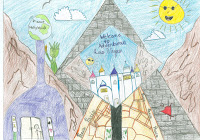
No matter where I've lived I've always taught community based art education with my students. This is a lesson from a school wide unit on Arts in Las Vegas. For this project I asked my students to create a new Welcome to Las Vegas sign for visitors to see on the strip. I did this project with my fourth grade classes and to get the "brain juices" flowing I asked them what their favorite place in Las Vegas is. I got a lot of responses with regards to the strip (Circus Circus, Adventuredome, Grand Canyon Experience, Mandalay bay Shark Reef), some were nation wide chains like Mcdonalds (which I would not allow), and then I started pushing them further. I asked them what their favorite restaurants were, what they do outside, what they do on the weekends. Through those questions I got many ideas that only locals in this area would know and would add diversity to the assignment. I showed them step by step how to measure the sign out on their paper (I could have made copies of the shape, but i thought they would learn more this way). Then they decorated their sign and drew a corresponding background, filled it in with color pencils. This one is my favorite so far. While it is the strip, the composition has a lot of information and is dynamic.
Glue Caps
I highly recommend these glue caps. They avoid over using the glue and they are easy to keep clean so the little ones won't stress when they can't get their glue out.http://www.discountschoolsupply.com/Product/ProductDetail.aspx?product=3359
Monday, November 12, 2007
Some Student Work
Check out www.crayola.com/artexpo and scroll to see the artwork from Nevada. So far I am the only art teacher who has submitted artwork for this online exhibition. The work was created by my 3 art clubs.
How I Got my Job
I received my New York State Teacher's License in the spring of 2004. I immediately began the job search process. My college (Buffalo State) held an annual job search convention for teachers in downtown Buffalo. Districts from all over the country came in, interviewed, and made job offers. I stuck mostly with districts from New York and Texas, where I had family. I made some great progress with Syracuse City Schools as far as receiving a job offer. This was in the spring. Throughout the summer I applied to all the school districts in upstate New York, Texas, and Clark County School District. I checked the employment pages of the local newspaper and called back regarding positions at the districts I had applied to. I got very close to having a job in Syracuse at the beginning of the fall, but it fell through at the last minute. So then I scrambled to figure out how I could make a living and further my career.
I ended up living at home that year and running an after school program in a suburban daycare center where I had worked part-time during college. The pay was enough to keep me out of my parents' hair and they gave me a scholarship to begin my Master's degree at Buffalo State College. I was miserable, but making due.
That spring I had a terrible infection from the little ones and decided I had had enough of the daycare buisness. I would rely on subbing the next year if I had to. That summer I continued taking courses at Buffalo State College and resubmitted all of my applications. I had three interviews that summer. The first two didn't work out, the last one was a part time long term sub position at Alden Central Schools in their middle school. I got it, and I loved it! I was finally an art teacher! The only bad part was that in 13 weeks it would be over. When that stress began, Clark County School District sent out a hiring rep to Buffalo. I set up an interview. It took 10 minutes, and at the end the rep told me to pack my bags and say goodbye to my family. I crossed my fingers.
Two weeks later I was driving from the middle school to Buff State and my mom called me saying a vice principal from Clark County was calling about a position. I immediately called the hiring rep to get more details. It was a brand new school in Las Vegas, had a large population due to growth in Northern Las Vegas, and needed an itinerant art teacher full time. That evening the vice principal offered me the job, and that I began looking for an apartment.
I still teach at that school, I am no longer the itinerant. I have my own classroom and a great group of kids who I have grown with.
I ended up living at home that year and running an after school program in a suburban daycare center where I had worked part-time during college. The pay was enough to keep me out of my parents' hair and they gave me a scholarship to begin my Master's degree at Buffalo State College. I was miserable, but making due.
That spring I had a terrible infection from the little ones and decided I had had enough of the daycare buisness. I would rely on subbing the next year if I had to. That summer I continued taking courses at Buffalo State College and resubmitted all of my applications. I had three interviews that summer. The first two didn't work out, the last one was a part time long term sub position at Alden Central Schools in their middle school. I got it, and I loved it! I was finally an art teacher! The only bad part was that in 13 weeks it would be over. When that stress began, Clark County School District sent out a hiring rep to Buffalo. I set up an interview. It took 10 minutes, and at the end the rep told me to pack my bags and say goodbye to my family. I crossed my fingers.
Two weeks later I was driving from the middle school to Buff State and my mom called me saying a vice principal from Clark County was calling about a position. I immediately called the hiring rep to get more details. It was a brand new school in Las Vegas, had a large population due to growth in Northern Las Vegas, and needed an itinerant art teacher full time. That evening the vice principal offered me the job, and that I began looking for an apartment.
I still teach at that school, I am no longer the itinerant. I have my own classroom and a great group of kids who I have grown with.
Who I am and How I Got Here
My name is Liza Camhi and I am an art teacher in Las Vegas. I have been teaching for 3 years in the Clark County School District and have been working with children for 8 years. I am originally from Buffalo, NY: which is where I earned my BFA in Painting at SUNY at Buffalo and my teaching license at SUC at Buffalo. I currently in the middle of my Masters program at UNLC in Curriculum and Instruction: Art Education.
Being an art teacher is an everyday challenge, passion, opportunity for growth, and can sometimes seem impossible. That is why I am creating this forum. As a new art teacher I have been through the uphill battle of the job search, the interviews, the cross-country move, teaching without a classroom, teaching in a multicultural urban setting, and dealing with behavioral issues concerning my students. I want to share the information I needed when I was dealing with these challenges with both new teachers and experienced art educators.
I will be posting my experiences, lesson plans and curriculum, stress management tips, job search information, and any other topics concerning art education.
Being an art teacher is an everyday challenge, passion, opportunity for growth, and can sometimes seem impossible. That is why I am creating this forum. As a new art teacher I have been through the uphill battle of the job search, the interviews, the cross-country move, teaching without a classroom, teaching in a multicultural urban setting, and dealing with behavioral issues concerning my students. I want to share the information I needed when I was dealing with these challenges with both new teachers and experienced art educators.
I will be posting my experiences, lesson plans and curriculum, stress management tips, job search information, and any other topics concerning art education.
Subscribe to:
Posts (Atom)